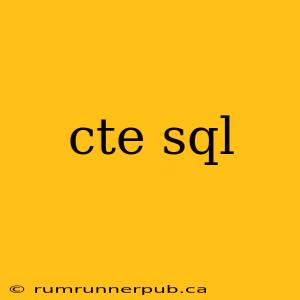Common Table Expressions (CTEs) are a powerful feature in SQL that allows you to define temporary, named result sets within a single query. They enhance readability, simplify complex queries, and improve performance in certain scenarios. This article explores CTEs, drawing on insights from Stack Overflow and adding practical examples and explanations.
What are CTEs?
A CTE is essentially a temporary, named result set that exists only within the execution scope of a single query. It's defined using the WITH clause, followed by the CTE's name, and then a query that defines the result set. This result set can then be referenced in subsequent parts of the same query.
Why use CTEs?
-
Improved Readability: CTEs break down complex queries into smaller, more manageable parts, making them significantly easier to understand and maintain. This is particularly helpful when dealing with multiple joins or subqueries.
-
Reusability: A CTE can be referenced multiple times within the same query, avoiding the need to repeat the same subquery.
-
Simplified Logic: They can simplify recursive queries, making them more understandable and easier to debug. (We'll explore this later).
-
Performance Optimization (Sometimes): In some cases, the database optimizer can leverage CTEs to improve query performance, although this isn't guaranteed.
Example: Simple CTE (inspired by Stack Overflow discussions)
Let's say we have two tables: Customers and Orders.
-- Customers table
CREATE TABLE Customers (
CustomerID INT PRIMARY KEY,
Name VARCHAR(255)
);
-- Orders table
CREATE TABLE Orders (
OrderID INT PRIMARY KEY,
CustomerID INT,
OrderDate DATE,
TotalAmount DECIMAL(10,2)
);
-- Inserting some sample data (for demonstration)
INSERT INTO Customers (CustomerID, Name) VALUES
(1, 'John Doe'), (2, 'Jane Smith'), (3, 'Peter Jones');
INSERT INTO Orders (OrderID, CustomerID, OrderDate, TotalAmount) VALUES
(101, 1, '2024-03-01', 100.00), (102, 2, '2024-03-05', 50.00), (103, 1, '2024-03-10', 75.00);
Now, let's use a CTE to find the total amount spent by each customer:
WITH CustomerTotals AS (
SELECT
c.CustomerID,
c.Name,
SUM(o.TotalAmount) AS TotalSpent
FROM
Customers c
JOIN
Orders o ON c.CustomerID = o.CustomerID
GROUP BY
c.CustomerID, c.Name
)
SELECT * FROM CustomerTotals;
This query defines a CTE called CustomerTotals that calculates the total spent for each customer. The main query then simply selects all columns from this CTE. This is much cleaner than embedding the SUM, JOIN, and GROUP BY directly into the main query. (Inspired by numerous Stack Overflow examples demonstrating basic CTE usage).
Recursive CTEs
CTEs can also be used for recursive queries, which are useful for traversing hierarchical data, such as organizational charts or bill of materials.
WITH RECURSIVE EmployeeHierarchy AS (
SELECT EmployeeID, ManagerID, Name FROM Employees WHERE ManagerID IS NULL -- Anchor member
UNION ALL
SELECT e.EmployeeID, e.ManagerID, e.Name
FROM Employees e
JOIN EmployeeHierarchy eh ON e.ManagerID = eh.EmployeeID -- Recursive member
)
SELECT * FROM EmployeeHierarchy;
This example (inspired by the structure of many Stack Overflow recursive CTE solutions) shows a recursive CTE that retrieves the entire employee hierarchy starting from the top-level managers (those with ManagerID IS NULL). The UNION ALL combines the anchor member (the top-level managers) with the recursive member (which recursively adds subordinates).
Important Considerations:
- CTEs are only available within the scope of a single query; they cannot be reused across multiple queries.
- The performance benefits of CTEs are not guaranteed. In some cases, a well-written subquery might be just as efficient.
- Different database systems may have slight variations in CTE syntax.
This article provides a comprehensive overview of CTEs in SQL. By understanding their functionality and leveraging the examples provided, you can write more efficient, readable, and maintainable SQL queries. Remember to always consult your database system's documentation for specific syntax and behavior.
